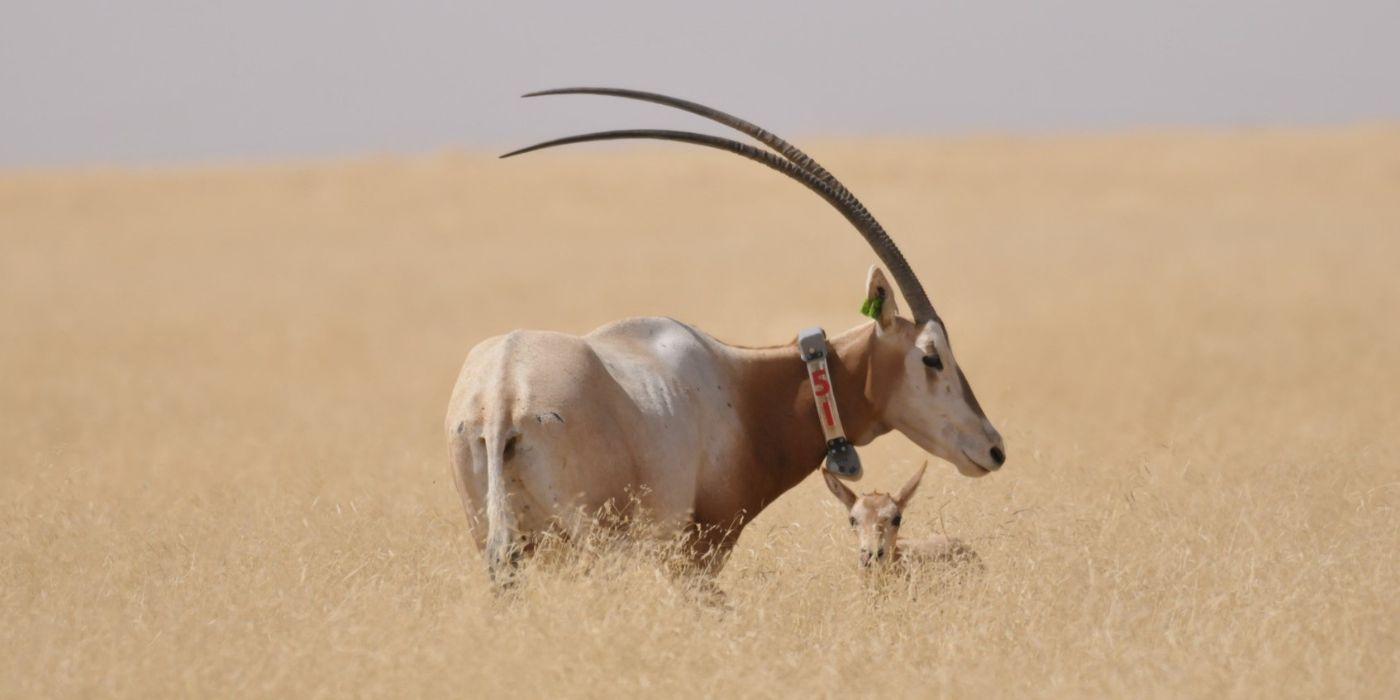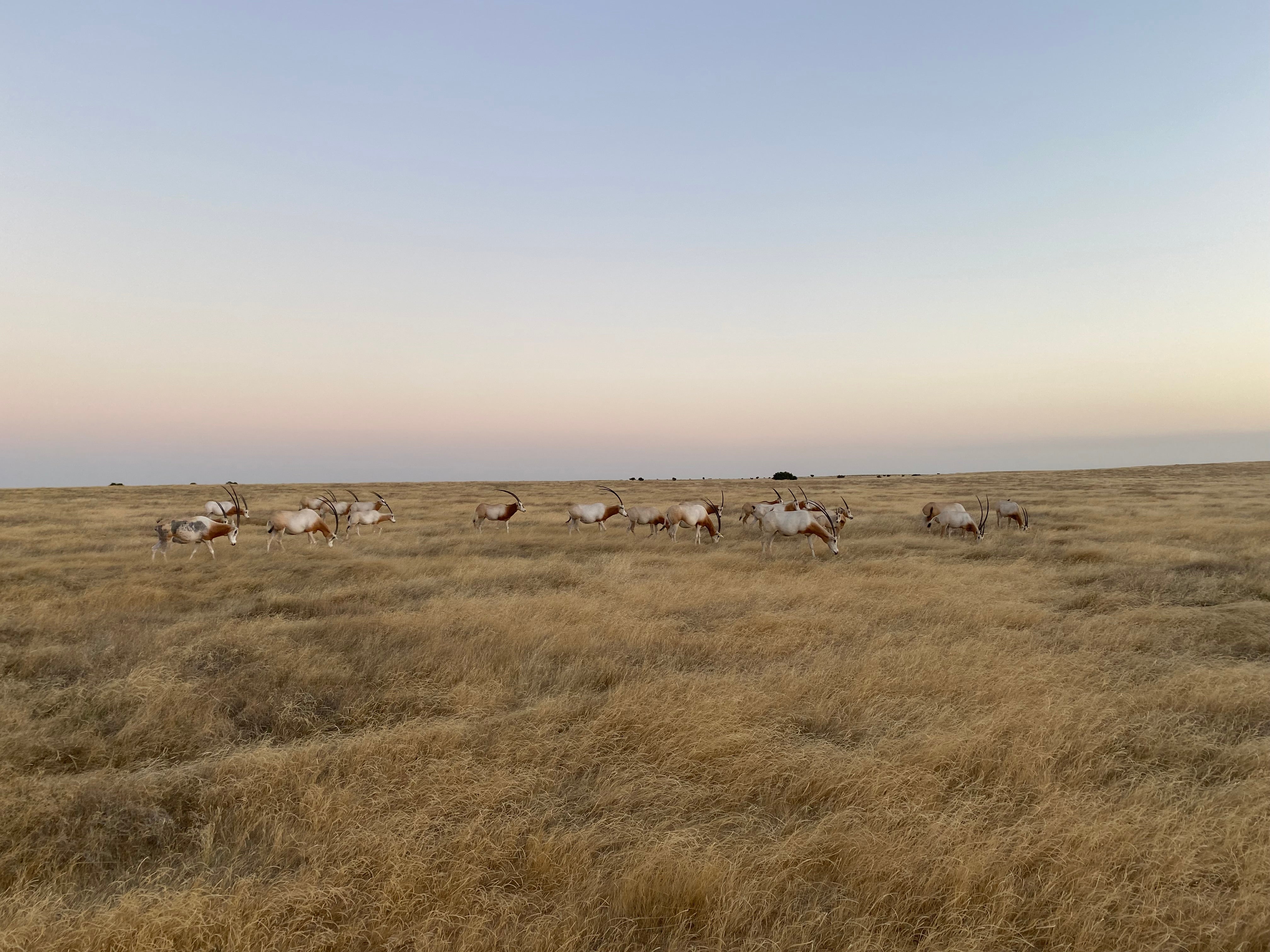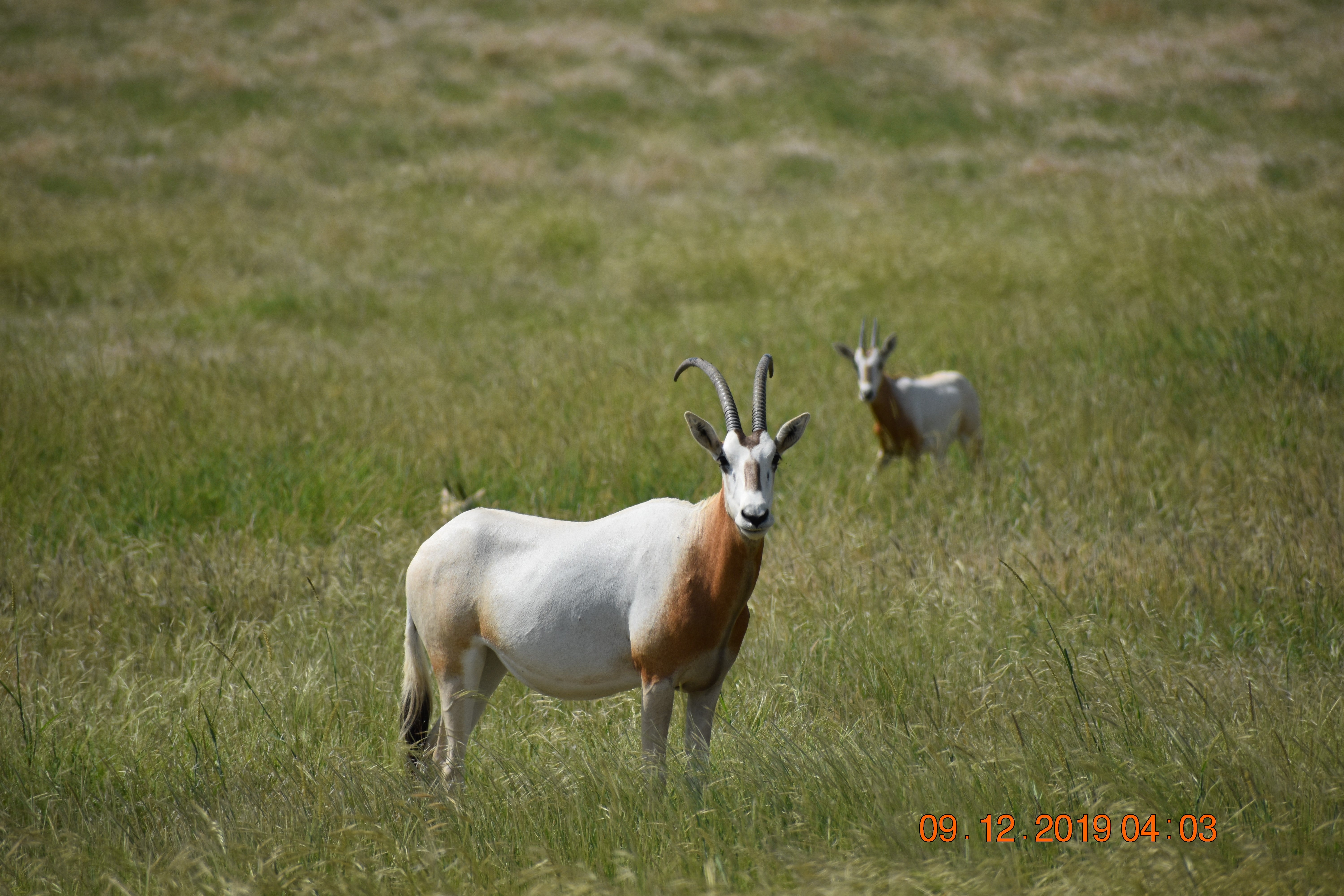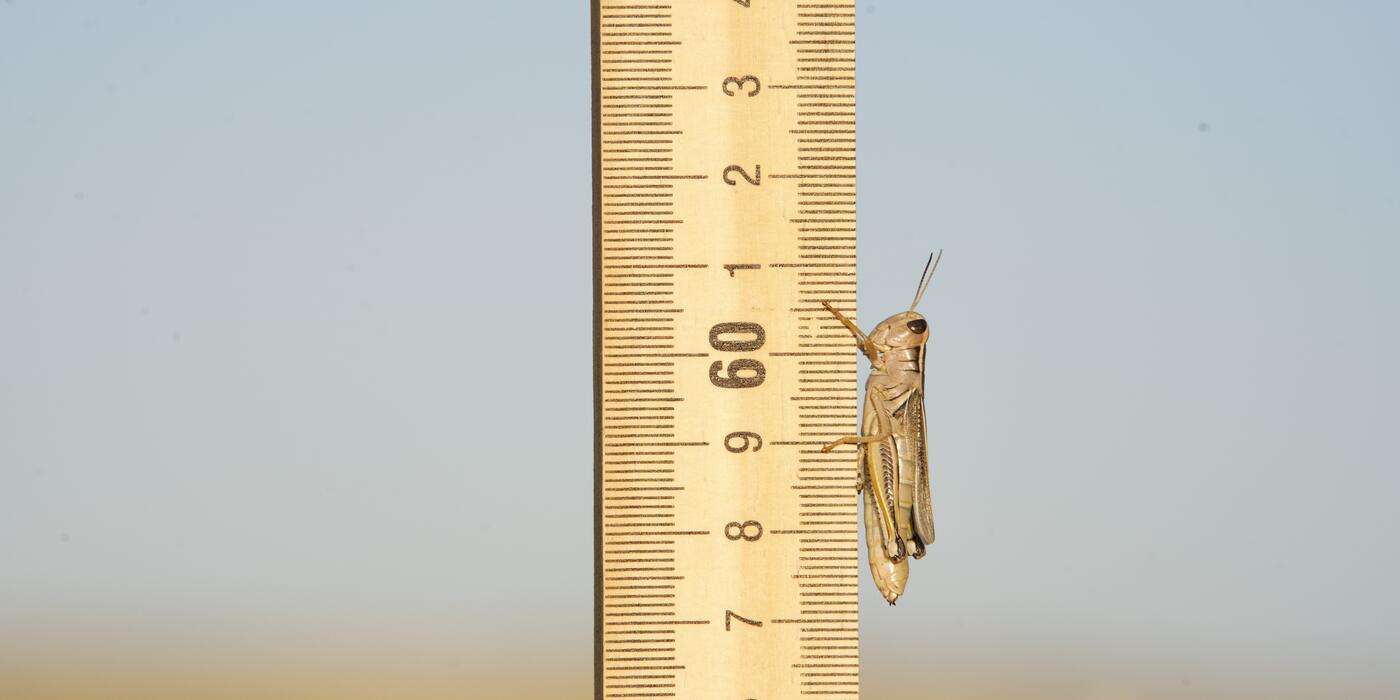Once Extinct in the Wild, Scimitar-horned Oryx Are Back From the Brink
Twenty-three years after being declared “extinct in the wild”, the scimitar-horned oryx has made a remarkable comeback. In December 2023, following decades of conservation efforts, the International Union for Conservation of Nature downlisted the scimitar-horned oryx as “Endangered.” Smithsonian research ecologist Katherine Mertes shares how oryx reached the turning point, and how conservationists hope to apply lessons learned for the benefit of other species.
What is the scimitar-horned oryx?
The scimitar-horned oryx is a large antelope: full-grown adults are larger than the white-tailed or mule deer we’re familiar with in the United States, more similar in size to a reindeer or caribou. Hundreds of thousands of oryx once ranged across the grasslands fringing the Sahara Desert.
Why did they become extinct in the wild?
Scimitar-horned oryx were historically hunted for meat and leather. Unfortunately, the modern vehicles and weapons that flooded into North, Central and West Africa during World War II increased human hunting capacity across the species’ range. Decades of regional political instability further increased hunting pressure on oryx and other traditional game species. The last sightings of wild scimitar-horned oryx were reported from Chad and Niger in the 1980s, and the IUCN declared the species to be “extinct in the wild” in 2000.
Luckily, when the scimitar-horned oryx disappeared from the wild, key elements for its restoration were already in place: a large population in human care, supportive governments in former range states, and invested stakeholders.
How did the global community come together to preserve the scimitar-horned oryx?
Since the 1960s, thousands of scimitar-horned oryx have been under human care in zoos and private collections, providing researchers access to a genetically diverse population. In the 1980s and 1990s – even before the species was classified as “extinct in the wild” – small numbers of scimitar-horned oryx were released into large enclosure in Tunisia, Morocco and Senegal. Between 2009 and 2012, stakeholders came up with an ambitious plan to fully reintroduce oryx on a broader scale. Meetings and workshops covered lessons learned from small-scale reintroductions, evaluated potential release sites, and ran models to understand how many animals would need to be translocated to produce a viable population.
In 2013, the Environment Agency – Abu Dhabi (EAD), inspired by the conservation legacy of the late Sheikh Zayed bin Sultan Al Nahyan, established a partnership with the Chadian government and the nonprofit organization Sahara Conservation to reintroduce scimitar-horned oryx into Chad. The resulting reintroduction program is based in the Réserve de Faune de Ouadi Rimé-Ouadi Achim (RFOROA) and implemented by Sahara Conservation. The substantial funding and leadership provided by EAD and the Crown Prince Court, and the technical capacities contributed by project leaders, founders, and partners have enabled the release of nearly 300 scimitar-horned oryx since 2016.
It’s hard to overstate the importance of any of these steps or players. Just building the reintroduction program’s release site in the RFOROA required incredible vision, financial support and dedication to conservation; the reserve is roughly the size of Maine, without any paved roads or permanent infrastructure. After this critical development, many partners with different skill sets came together to breed, translocate, release, monitor and manage scimitar-horned oryx in the reserve.
Scimitar-horned oryx nuzzles her wild-born calf in the Réserve de Faune de Ouadi Rimé-Ouadi Achim, Chad.
What is the Smithsonian’s role in the reintroduction program?
We play technical and scientific roles in the scimitar-horned oryx reintroduction program in Chad, especially for post-release monitoring. Our scientific objectives change with the stage and needs of the program, but our priorities include learning about oryx population dynamics, space use, and habitat preferences. For me, this largely means managing and analyzing data collected by tracking devices fit to scimitar-horned oryx, and working with other Smithsonian scientists and external collaborators to learn all we can from these data.
To be truly useful, tracking technology needs to suit the animals being monitored and function reliably under field conditions – including conditions we can’t always predict, such as extreme weather or unexpected animal behaviors. Before any scimitar-horned oryx were released in Chad, NZCBI researchers tested different models of GPS / satellite collars on oryx living at the Zoo’s research campus in Front Royal, Virginia and Fossil Rim Wildlife Center in Glen Rose, Texas. Based on our captive trials, we selected the best-fitting, best-performing collar for scimitar-horned oryx reintroduced into Chad. Once we identified the best collars, we worked with program partners to design a post-release monitoring program. I’ve spent many hours ordering and managing tracking devices, making sure production and shipping timelines work with animal transport and release schedules, and have fit hundreds of GPS / satellite collars and other tracking devices on animals in the US, Abu Dhabi, and Chad.
I also work closely with the team monitoring reintroduced oryx and other species in the RFOROA, planning monitoring activities, discussing animal events like births and mortalities, and troubleshooting issues with tracking devices and other equipment. Two to four times a year, I travel to the RFOROA to fit tracking devices to animals and work with the field monitoring team in person.
How does tracking technology inform better management practices?
Everything we learn about reintroduced scimitar-horned oryx feeds into their management, the reserve’s management and future reintroduction practices.
For example, we found that reintroduced scimitar-horned oryx released during dry months and provided with supplemental food and water, moved much less and didn’t disperse from the release site. Essentially, these animals didn’t learn how to forage on their own during their first dry season and continued to stay closer to the release site over time compared to other release groups. Based on these findings, the reintroduction program limited releases to the rainy and early cool/dry season to encourage animals to disperse across the landscape.
Later, we analyzed a large set of collar data and found that scimitar-horned oryx experience three seasons across a typical year – rainy, cool/dry and hot/dry. When we divided years into these three seasons, we found that reintroduced oryx used different areas within the reserve during different seasons. In 2021, Sahara Conservation designated “enhanced conservation zones” within the RFOROA to include these seasonally important areas.
How do you consider a reintroduction program to be successful?
The first criterion for “success” of the scimitar-horned oryx reintroduction in Chad is a simple number. In reintroduction ecology, the term “viable” describes a population that can sustain itself over the long term without human intervention. Larger populations are generally more viable than smaller populations, because while a catastrophe (like a disease outbreak or severe weather event) may cause many mortalities, it probably won’t wipe out the whole population.
In conservation, success always has more than one dimension. The RFOROA is a mixed-use landscape, and mobile agropastoralists graze millions of goats, sheep, cows and camels inside its borders every year. Strengthening relationships with these communities and working with them to prioritize sustainable use of the reserve and its wildlife into the future would further support the viability of the reintroduced oryx population and serve as another indicator of success.
How does the success of the scimitar-horned oryx reintroduction program help other endangered species?
When EAD, the government of Chad and Sahara Conservation built animal pens and a base camp in the RFOROA, they created both a foundation and an umbrella for conservation. In 2016, the first scimitar-horned oryx were released into the reserve. In early 2020, EAD translocated the first addax; since then, nearly 100 addax have also been released. Later in 2020, Sahara Conservation captured several dama gazelles from a population in Western Chad that is now thought to be extinct; in 2021, EAD translocated five dama gazelles from an ex-situ population to the RFOROA. From these founders, a small captive breeding population of dama gazelle now also exists in the reserve. These are conservation actions of enormous impact for multiple critically endangered species – and they simply would not be possible without the investment and infrastructure of the scimitar-horned oryx reintroduction program.
Reintroduction, management and monitoring practices that have worked well in the RFOROA may also work well in other spaces. For example, the National Agency for Water and Forests in Morocco has initiated several reintroduction programs for oryx and other arid land ungulates. Compiling “lessons learned” so far from the oryx reintroduction in the RFOROA could provide a valuable road map for projects reintroducing similar species or occurring across similar landscapes.
The Oryx Reintroduction Project in Chad is a joint initiative of the Environment Agency - Abu Dhabi and the Government of Chad. Under the overall leadership and management of the Environment Agency - Abu Dhabi, implementation on the ground is carried out by Sahara Conservation, in partnership with the Ministère de l'Environnement, de la Pêche et du Développement Durable. The Smithsonian National Zoo and Conservation Biology Institute extends its gratitude to the Environment Agency - Abu Dhabi, the Government of Chad and Sahara Conservation for the opportunity to assist in the project's implementation.
Additional thanks to reintroduction program partners at the Zoological Society of London, the Royal Zoological Society of Scotland, Fossil Rim Wildlife Center, the Saint Louis Zoo and Marwell Zoo.
Related Species:




